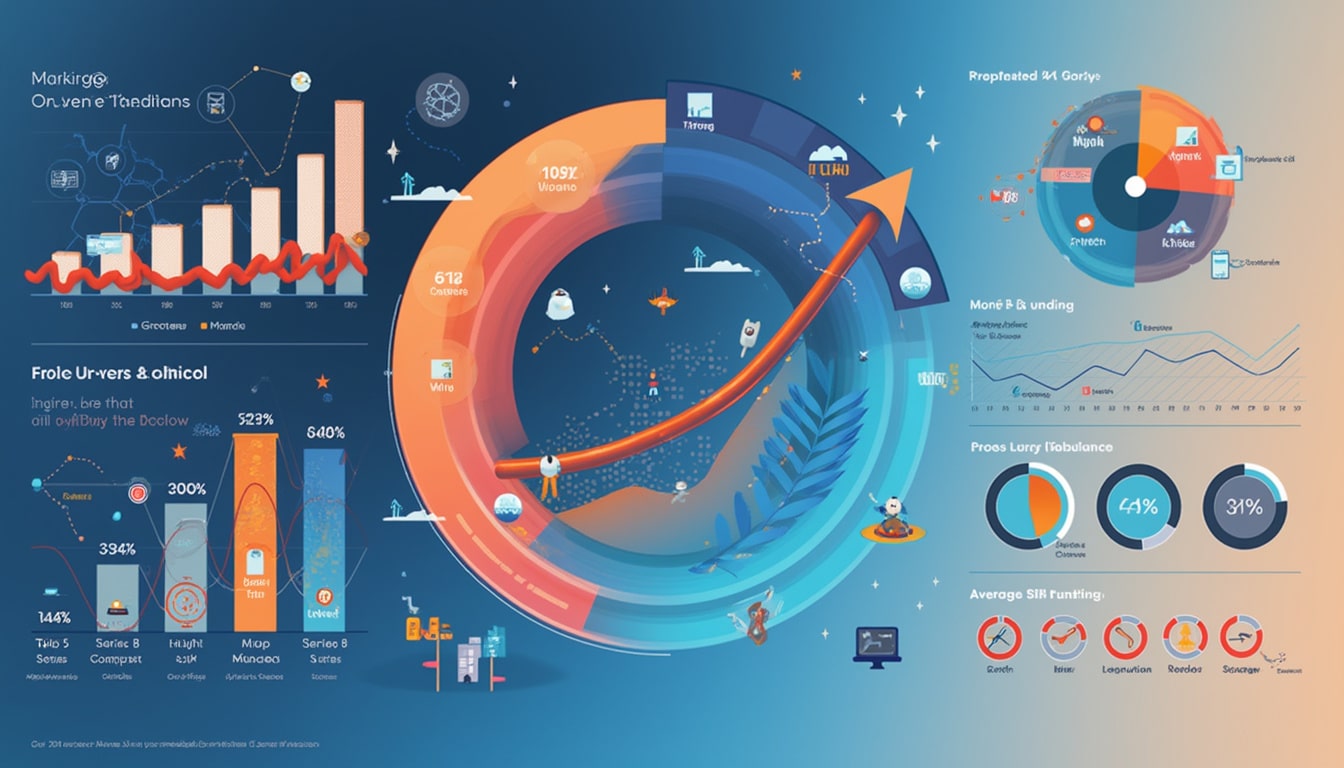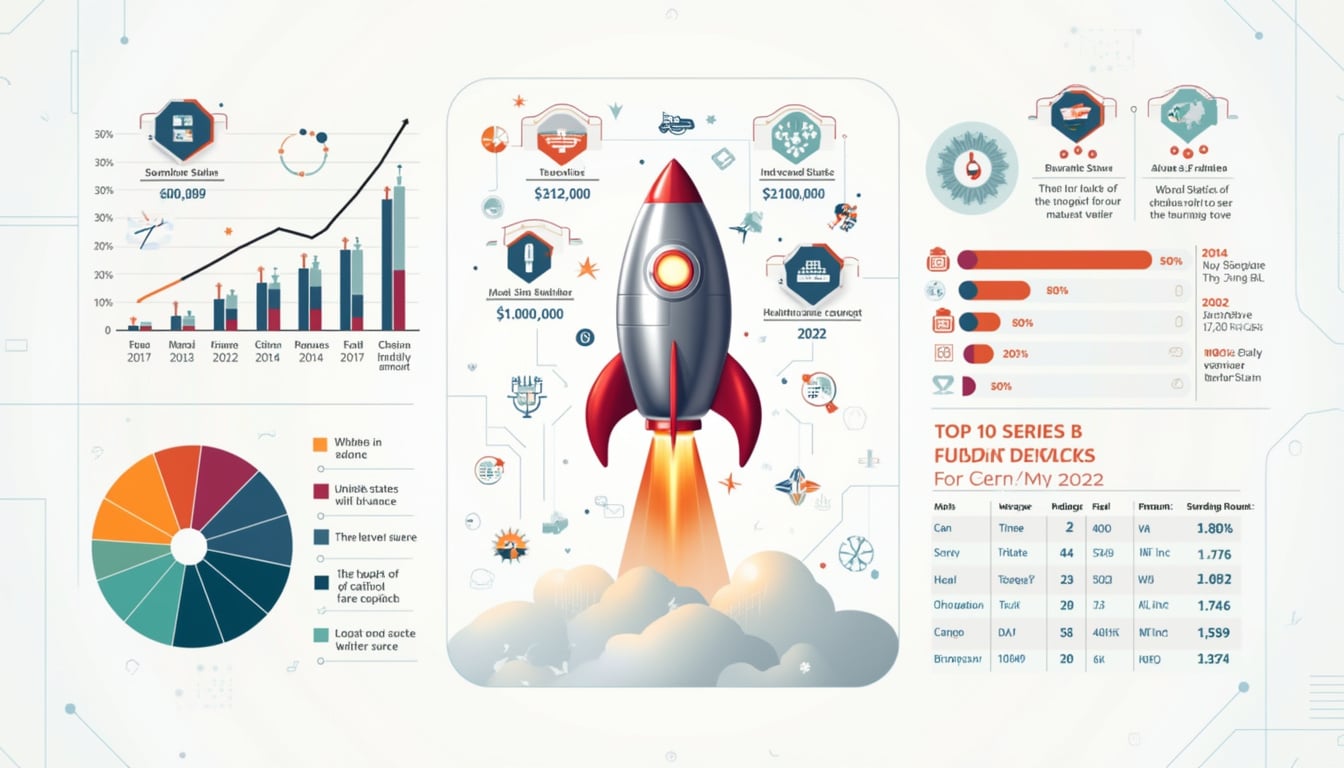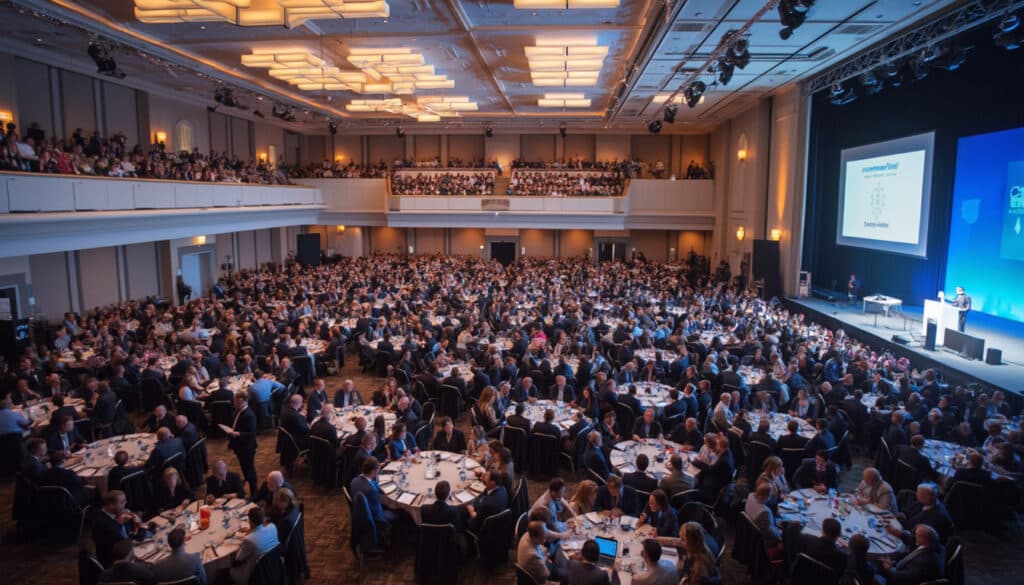Navigating the funding gap is a complex adventure.
For SaaS startups, reaching Series A is the first major success.
But the real challenge begins with Series B.
Each new funding round becomes more challenging, requiring sustained growth and solid metrics. Recent data from Carta, analyzing 10,755 American startups in Series A, offers enlightening insights on the progression rates to Series B. This information is crucial for B2B founders looking to navigate this competitive environment. Understanding current trends allows for better anticipation of challenges and adaptation of strategies accordingly. Patience and efficiency become the keywords for ensuring a successful transition between different funding phases. By adapting their approaches, startups can maximize their chances of long-term success. This detailed analysis provides valuable lessons for anyone aspiring to evolve their business to new heights.
The success rate from Series A to B: a reality based on data
Carta’s comprehensive data reveals several critical insights on the progression from Series A to Series B:
- The time horizon is of considerable importance: The probability of securing Series B funding increases substantially over time. For cohorts that have reached sufficient maturity (2018-2020), progression rates reach 40-50%+ by the fourth year, compared to just 1-4% in the first quarter after Series A.
- The vintage effect is real: Startups that raised a Series A between 2018 and 2020 show higher graduation rates to Series B than those that raised it in 2021 or later. The cohort from the first quarter of 2020 shows particularly strong performance, with over 55% reaching Series B by the fourth year.
- The current funding winter: A visible decline in graduation rates is observed for startups that raised a Series A from 2021, with significantly lower progression percentages across all time horizons.
- Signs of recovery: As indicated by the note on the graph, there are “signs of life” with slightly increased graduation rates in more recent cohorts – a cautiously optimistic indicator for the current funding environment.
Implications for SaaS founders
- Plan for the long term: The data clearly shows that the path to Series B is a marathon, not a sprint. Specifically for SaaS companies:
- Most Series A companies succeed in securing Series B funding within 2-3 years.
- The median time between funding rounds is about 24 months.
- Only a small minority (typically less than 10%) secure further funding within the first six months.
Action: Structure your Series A round to provide at least 24-30 months of runway, with contingency plans to extend if necessary.
- Most Series A companies succeed in securing Series B funding within 2-3 years.
- The median time between funding rounds is about 24 months.
- Only a small minority (typically less than 10%) secure further funding within the first six months.
- Understand new metric norms for Series B SaaS: The funding environment since 2021 has reset expectations. Series B SaaS companies typically need to demonstrate:
- $4-8M in ARR (compared to $2-4M before 2021)
- Annual growth of 2-3x (with some flexibility for greater efficiency)
- A clear path to profitability with improving unit economics
- Customer acquisition cost (CAC) payback periods under 18 months
- Net revenue retention above 110%
Action: Build your post-Series A strategy around these specific indicators rather than superficial metrics.
- $4-8M in ARR (compared to $2-4M before 2021)
- Annual growth of 2-3x (with some flexibility for greater efficiency)
- A clear path to profitability with improving unit economics
- Customer acquisition cost (CAC) payback periods under 18 months
- Net revenue retention above 110%
- Capital efficiency is the new growth: The data shows that 2021 was a turning point, with a significant decline in graduation rates. This coincides with the shift from “growth at all costs” to “efficient growth”:
- Companies that raised a Series A in 2020 or earlier could often secure a Series B primarily based on growth metrics.
- Post-2021 companies face stricter scrutiny on burn rate and capital efficiency.
Action: Focus on improving your efficiency metrics such as gross margin, CAC ratio, and burn multiple alongside growth.
- Companies that raised a Series A in 2020 or earlier could often secure a Series B primarily based on growth metrics.
- Post-2021 companies face stricter scrutiny on burn rate and capital efficiency.
- The graduation window is extended: Looking at the cohort analysis, we find that graduation rates continue to improve even 3-4 years after Series A:
- For the 2018-2019 cohorts, significant jumps in graduation rates occur in years 3 and 4.
This suggests that patience and perseverance can pay off.
Action: Consider alternative financing strategies (venture debt, extension rounds) that can extend your runway while you build towards Series B metrics. - For the 2018-2019 cohorts, significant jumps in graduation rates occur in years 3 and 4.
Signs of hope in the current environment
The note on the graph pointing to “signs of life” in more recent cohorts deserves special attention. Although graduation rates for the 2021-2023 cohorts are generally lower compared to 2018-2020, we can observe:
- The T4 2022 and T1 2023 cohorts show higher early graduation rates than previous quarters.
- The improvement slope for recent quarters appears to be accelerating.
For SaaS founders, this suggests that while the requirements remain high, investors are actively deploying capital toward companies meeting the new efficiency-focused criteria.
Strategic implications for SaaS founders
- Optimize for the “Three R’s”: Revenue, Retention, and Runway are now the critical factors for success in Series B:
- Revenue: Focus on quality revenue from ideal customer profiles.
- Retention: Prioritize net revenue retention as your star metric.
- Runway: Manage your burn rate to ensure you can sustain extended funding timelines.
- Revenue: Focus on quality revenue from ideal customer profiles.
- Retention: Prioritize net revenue retention as your star metric.
- Runway: Manage your burn rate to ensure you can sustain extended funding timelines.
- Consider the “Series A+” path: The extended timelines indicated by the data suggest that bridge rounds are becoming increasingly normal:
- 25-35% of companies succeeding in Series B are now raising interim funding.
- This can be structured as Series A extensions, A-1 rounds, or strategic investments.
- 25-35% of companies succeeding in Series B are now raising interim funding.
- This can be structured as Series A extensions, A-1 rounds, or strategic investments.
- Sector-specific benchmarks matter: While aggregate data is informative, graduation rates vary significantly by sector:
- Enterprise SaaS with longer sales cycles often takes longer to reach Series B.
- Product-led growth SaaS generally shows faster progression paths.
- Infrastructure and development tools face different investor expectations than application software.
- Enterprise SaaS with longer sales cycles often takes longer to reach Series B.
- Product-led growth SaaS generally shows faster progression paths.
- Infrastructure and development tools face different investor expectations than application software.

Table of Contents
ToggleUnderstanding the current state of the market for Series B funding
Navigating the world of Series B fundraising can seem complex, especially in the current economic climate. For SaaS startups, obtaining Series B funding is a crucial step that demonstrates successful initial traction. However, each funding round generally becomes more demanding, requiring strong growth and robust metrics. Let us analyze the current trends and effective strategies to succeed in this essential transition.
Why is the time between Series A and B so important?
Time plays a decisive role in the success of a Series B fundraising effort. According to recent data from Carta analyzing 10,755 American startups in Series A, the probability of obtaining Series B funding increases significantly over time. For mature cohorts from 2018 to 2020, progression rates reach over 40-50% by the fourth year, compared to just 1-4% in the first quarter after Series A.
This time horizon is essential as it allows companies to demonstrate continued growth and steady performance. Startups should therefore plan long-term, structuring their Series A funding to offer a sufficient financial runway of 24 to 30 months. This preparation is crucial for ensuring a smooth transition to Series B, thus avoiding early financial pressures.
What are the new performance criteria for a successful Series B?
Since 2021, investor expectations for Series B companies have evolved, emphasizing stricter metrics and increased capital efficiency. SaaS startups must now demonstrate:
- Annual recurring revenue (ARR) of $4 to $8 million, compared to $2 to $4 million before 2021.
- An annual growth of 2 to 3 times, with some flexibility for increased efficiency.
- A clear path to profitability, with improved unit economics.
- Customer acquisition cost (CAC) payback periods under 18 months.
- Net revenue retention above 110%.
These criteria aim to ensure that companies do not focus solely on growth at all costs, but also demonstrate sound financial management and long-term sustainability. It is crucial for founders to structure their post-Series A strategy around these key indicators rather than getting distracted by vanity metrics.
How to optimize capital efficiency to foster growth?
Capital efficiency has become a determining factor in the current funding landscape. Since 2021, there has been a significant shift in mentality, moving from expansion at all costs to efficient growth. Companies that raised funds in Series A before 2021 can generally secure a Series B based primarily on their growth metrics. In contrast, post-2021 startups are subjected to a more rigorous examination of their burn rate and financial efficiency.
To improve efficiency, it is essential to focus on metrics such as gross margin, CAC ratio, and burn multiple, in addition to growth. This involves reducing non-essential costs, optimizing operational processes, and maximizing returns on every invested dollar. Resources like Workato’s innovations in enterprise integrations can provide solutions to automate and improve operational efficiency.
What strategies to adopt in the face of an extended graduation window?
Analysis of the 2018-2019 cohorts shows that graduation rates continue to improve even 3 to 4 years after Series A. This suggests that patience and perseverance can pay off in seeking Series B funding. Founders should consider alternative strategies such as bridge financing, venture debt, or extension rounds to prolong their financial runway while working to achieve the necessary metrics for Series B.
These strategies not only help maintain the company during transition periods but also provide the necessary time to adjust operations and optimize performance. By offering robust contingency plans, startups can navigate fundraising phases more smoothly.
What signs of hope exist in the current funding environment?
Despite a general slowdown in graduation rates for the 2021-2023 cohorts, signs of recovery are beginning to emerge. The data indicates that the late 2022 and early 2023 cohorts display higher early graduation rates than previous quarters, with an accelerating slope of improvement. This suggests that, while the conditions remain demanding, investors are ready to deploy capital in companies that meet the new efficiency criteria.
For SaaS founders, this means there are still opportunities, provided they align with current performance and efficiency expectations. Recent examples like Acton Vend raising $53 million after 17 years in existence illustrate how well-structured companies can succeed even in a more rigorous funding environment.
What are the strategic imperatives for SaaS founders?
To successfully raise Series B funding, SaaS founders must focus on three key aspects: Revenue, Retention, and Runway.
Optimize revenue
Focus on quality revenue from ideal customer profiles. This involves clearly identifying your target market and developing offerings that precisely meet their needs.
Improve retention
Net revenue retention should be your key metric. High retention indicates strong customer satisfaction and ongoing product value, which is attractive to investors.
Manage financial runway
Ensure you effectively manage your burn rate so you can sustain prolonged periods of fundraising. Careful financial management builds investor confidence.
Additionally, some startups choose to follow the path of “Series A+”, raising interim funding to extend their financial runway while preparing for Series B. This approach is becoming increasingly normal, with 25-35% of companies succeeding in raising a Series B via interim funding.
How do sector benchmarks influence Series B fundraising?
Sector-specific benchmarks play a crucial role in investors’ evaluations. For example, enterprise-oriented SaaS companies, with longer sales cycles, often take longer to reach Series B, while product-led growth companies generally show faster progression paths. Likewise, infrastructure tools and developer solutions face different investment expectations compared to application software.
Understanding these sector nuances allows founders to adjust their funding and performance strategies accordingly. For example, companies in the AI sector, such as OpenAI reaching revenues of $127 billion this year, need to align their metrics with the specific expectations of their domain to attract the right investors.
What is the importance of operational efficiency in Series B funding?
Operational efficiency has become a key criterion for Series B investors. Startups must demonstrate not only steady growth but also rigorous management of their resources. This includes optimizing gross margins, reducing CAC ratios, and improving burn multiples.
For instance, solutions like the impressive features of SaaStr’s free AI can help companies automate and optimize their processes, thus reducing costs and improving overall efficiency. Effective management not only maintains the financial health of the company but also provides solid figures to potential investors.
What are the recent trends and future prospects for Series B funding?
Recent trends show a shift towards a more sustainable and efficiency-focused approach in Series B fundraising. While graduation rates have decreased for new cohorts, signs of recovery indicate an adaptation by investors to new economic norms. The focus on profitability and efficiency sets the stage for more resilient and sustainable growth.
Companies like Rippling and the impact of AI on sales illustrate how the adoption of advanced technologies can enhance efficiency and performance, thus meeting the new expectations of investors. In the future, startups will need to continue to innovate and adapt their business models to remain attractive in an increasingly competitive funding environment.
In conclusion, successfully raising Series B funding requires a deep understanding of current market dynamics, strategic planning, and rigorous execution focused on efficiency and sustainable growth. By following these principles and remaining agile in response to market evolutions, SaaS startups can successfully navigate the next stages of their development.










